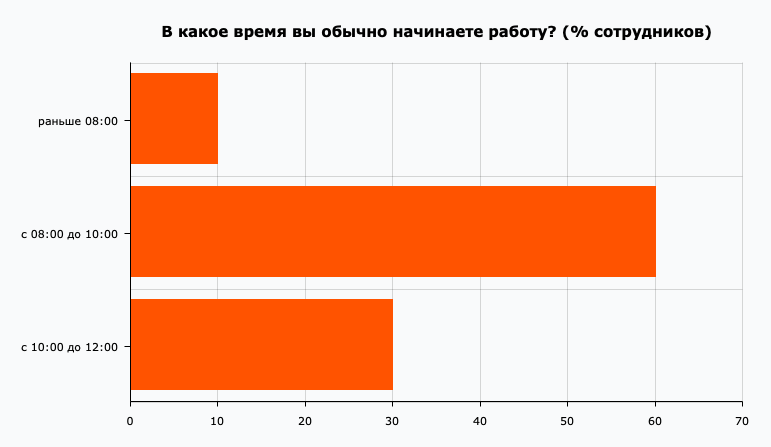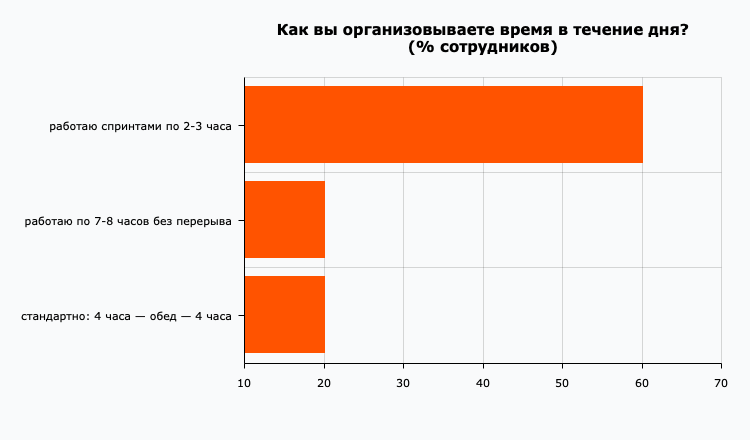Myths about remote employees that we destroyed ourselves

Hi, Habr. I’m an editor at Ratio, we do custom web development and from the beginning of 2018, all our employees work remotely. From Tallinn to Komsomolsk-on-Amur, seven time zones.
Our developers always worked from home, but there was also an office in Moscow, where some of the managers sat. We set up business processes so that it was convenient to work on a remote site, so that over time the office was empty by itself - it was closed without problems with discipline and deadlines.
Now the team has 20 people and there are no big difficulties with management. In the article I will tell you what myths about remote employees we destroyed.
Myth 1: remote employees are harder to control
On a remote site, the employer is afraid of losing control: it seems that the whole team will move to the tropics, managers will stop answering calls, and developers will drop projects and do surfing. A controlling tinsel appears around: webcams, screenshots and other joys of Big Brother.
This scheme seemed to us complex and slightly inhuman. Of course, we conduct tasks at YouTrack, but this is more for managerial accounting, to calculate the cost of projects and see when the team gets stuck. So we find out our weaknesses, then to help employees pump in competencies that are not enough.
If a person in a small company frankly hacks, this can be seen, so we are not afraid to give people freedom. Does this mean that remote employees are not suitable for large companies? Depends on how the interaction of departments is configured. If the chaos in business is to a minimum, and the company can be represented as a set of independent teams - there should be no problems.
Myth 2: remoters are inconsistent and not there when they are needed
We are helped by a simple rule: from 11:00 to 17:00 Moscow time, you need to be in touch in a corporate chat. It is not necessary to engage in work tasks at this time, the main thing is to reply to messages within 15 minutes.
This is how we make communication predictable — most of the discussions take place in these six hours. If you need to go offline, the employee warns the others in the general chat channel.
Regarding the inconsistency: let's be honest, nothing prevents the office employee from taking and one day not coming to work. The only question is how quickly you will notice the loss of a person on a remote site.
To be sure of the team, all agreements need to be formalized according to the TC and to make communication between employees organized. But more about this in the analysis of the following myth.
Myth 3: telecommuting makes communication difficult
It really becomes more difficult to communicate, but not because communication is becoming more complicated - it simply ceases to be unconscious. In the office there is always the opportunity to ask a question to a more experienced colleague or hurry a friend if he is delaying work. On a remote site you have to come up with special tools.
- Most conversations go through Rocket.Chat , deployed on our servers. We made channels for departments and projects in it, screwed up an informal floodlight - everything is as it should.
- Company news can be found in Notion , where the director once a month writes a detailed report: what did good, which clients are on the way and if there are problems with current projects. There we collect the company's knowledge base, regulations and design documentation.
- To make employees feel the presence of the team, we have mandatory meetings in Google Meet . For managers and designers once a week, for developers - three. If necessary, employees call up additionally to discuss a specific project.
This is enough to cope with the feeling of loneliness about which the remoters talk. But sometimes it’s worth encouraging informal chat discussions.

The other day, our developers arranged the first session of joint programming: those who wished worked in front of webcams and talked as if they were in the same office. The first experience turned out to be successful - in parallel with the work, small issues that would hang for a long time in the task tracker are solved.
Now we always have a shared Hangouts call open. People connect at will, if you want to feel like part of a team.
Myth 4: on a remote site it is more difficult to control data leaks
The truth is that you still won’t be able to control leaks without the corporate security department, and in small firms it’s usually not. If someone really wants to steal company data, he will do it sooner or later - it does not matter if he works on a remote site or in an office.
The main thing is to protect the team from chance. Set up two-factor authentication, choose passwords more difficult. In general, standard Internet security rules.
The company should have a single information circuit: access to services through corporate mail, documents for third parties are opened only by managers, and all passwords are stored in 1Password.
Myth 5: farmers sleep until noon
The obvious advantage of remote work is that you can finally get enough sleep and start the day when it is comfortable. But recently we conducted a survey among employees and the results surprised us.
60% of respondents start work in the interval from 08:00 to 10:00 - the same as in a regular office. Who says good code is not written in the morning? It is written, and how.
Before 08:00, 10% start the day, and from 10:00 to 12:00 only 30% sit down at the monitor.

At the same time, the peak of productivity for all occurs differently. 30% work best from 09:00 to 12:00, the other 30% - from 12:00 to 15:00. Early in the morning, 20% prefer to work, and the rest of the votes were equally divided between evening and late evening.
Myth 6: remote workers work in fits and starts and spend time on entertainment
60% of respondents actually wrote that they work as sprints. Here are just sprints turned out long, for 2-3 hours each. 20% work for 7-8 hours without a break - this concentration can only be envied.
The remaining 20% distributes time according to the classical scheme with slight variations: 4 hours - lunch - 4 hours.

Even those who work intermittently are rarely distracted by hobbies and entertainment. Most employees devote time to everyday life during the day: pick up the child from school, draw up documents, go to the hospital. Bytovuha, no romance.
Perhaps the fact is that our team is small. It’s difficult to get lost, so each person works on his conscience.
Myth 7: remote employees unevenly distribute the load during the week and process for the sake of an extra day off.
There is always the temptation to free half of Friday, staying at work on Wednesday or Thursday. We are not opposed, but the survey showed that only 30% of employees use this advantage. The remaining 70% adhere to the office schedule and work approximately the same number of hours each day.
Apparently, it’s easier for people to keep themselves in good shape - they know when to work and when to rest.
The problems that we actually encountered
Some customers do not trust contractors who do not have an address on the site . It is important to mention more often that all employees work in the state - customers confuse remote workers with freelancers, and the reputation of developers on freelance is so-so.
Not everyone is comfortable working from home . Once we even paid coworking to an employee, but in the end he realized that remote work didn’t suit him at all.
It's hard to take a team photo . If you need a photo for an article or a new section on a corporate website, there’s simply nowhere to take it from. Meetings of employees are held once every six months and they are not all.
The udalenka promotes recycling and burnout. Employers are afraid that the distributed team will hit the buck, but in fact the opposite is true: when the boundaries of the day are blurred, employees get used to the processing. We have to remind about the rest and follow the work schedule - otherwise fatigue, health problems and a decline in productivity.
